Please configure
Keep safe from scams
Scammers are constantly coming up with new tactics to exploit people, whether in person, over the phone, through text message, emails, or online. It’s important to be aware that Spark would never show up at your home or contact you asking for access to your computer without a prearranged appointment.
If you are ever in doubt, please call Spark directly on 123 to confirm that the visit or contact is legitimate. Below you’ll find further information, tips and scam examples to help you avoid falling victim to scammers.
Types of scams and tips to avoid them
Phishing scams
Phishing scams are fake emails, calls, texts or online pop-ups that come from people pretending to be from a trusted organisation such as your bank, telecommunications provider or even from the Government.
The term 'phishing' relates to people 'fishing' for information. Scammers send these messages to large groups of people with no particular targeting and usually aim to gain personal information from the victim, such as login details, passwords or credit cardnumbers. Scammers will often try to trick the victim into clicking on a link and entering information or downloading malware onto their device, which they can then use to exploit the victim.
Some phishing scams have additional characteristics, such as ‘spear phishing’ which is where the scammer is able to address you by name, or ‘whale phishing’, which is where the scammer targets business executives or officials and usually signs off as someone they trust.
Tips to avoid falling victim to phishing:
- Be critical when you receive an unexpected email, text or phone call as they may not be who they say they are. You can familiarise yourself with the various characteristics of phishing scams on Netsafe’s website: https://netsafe.org.nz/scam-tips/
- Avoid replying to emails or texts, or calling back a caller you don’t recognise
- Avoid clicking links in texts where possible
- Familiarise yourself with how to keep your information safe online to avoid becoming a target. Keep your information safe online
- If you're unsure whether a call is genuine, the best thing to do is hang up. You can call back the company using its official phone number on their website or in the phone book.
- Remember, Spark will never call you out of the blue and request your password, credit card details, threaten to disconnect you, tell you you’ve been hacked or request access to your personal devices.
- Spark helps prevent people falling victim to fraudulent Spark impersonations via email by adopting a technology called BIMI or ‘Brand Indicators for Message Identification’. This shows either our trademarked logo or a blue verification tick in the sender section of some email platforms when the communications are legitimate.
Spoofing
Spoofing is when a scammer uses a certain technology to make it look like an email, text, or phone call they make is coming from someone you recognise. This trick could be used as part of a phishing campaign to seem more trustworthy, or a scammer could use it to impersonate you and scam someone who trusts you.
Mobile number porting and SIM swapping fraud
Mobile number porting and SIM swapping fraud occurs when a scammer successfully transfers a victim’s mobile number onto a SIM card in their possession, often so they can receive text messages intended for the victim. In some circumstances, this can allow the scammer to authorise bank transactions if the customer is using text message based two-factor authentication (2FA) to protect their bank account. These scams are usually the final step in an elaborate scheme to steal from victims.
Mobile number porting
This is when the number is moved to a SIM card with a different provider. Because this process involves multiple mobile providers, we’ve worked with them to develop measures that help us confirm that a porting request is legitimate. The provider receiving a porting request will send a text message to the current SIM card holder letting them know the request has been made. For the port to be authorised, the current SIM card holder must reply ‘YES’ within two hours to confirm.
SIM swapping
This is when the number is moved to a SIM card with the same provider. People often request this kind of swap when they have lost their phone or when their phone has been stolen. To prevent fraudulent SIM swapping, we have implemented a process whereby customers must visit a Spark store and present identification before the swap can be approved.
It could mean you’ve been the victim of a fraudulent SIM swap or number port if:
- You lose mobile service in an area where you normally have it, and other peoples’ phones are still connected.
- You receive password reset notifications for accounts that use your mobile number for 2-Factor Authentication (2-FA).
If you think you may have been the victim of a fraudulent SIM swap or mobile port, contact your bank immediately then contact your mobile provider to get your number back.
Tips to avoid mobile number porting and SIM swapping fraud
- Set up 2FA on your bank account using app-based 2FA rather than text message or voicemail.
- If you get an unexpected text from a mobile provider asking to confirm a port, respond to the message with ‘N’ or ‘No’ immediately to prevent the port being authorised. You will receive a cancellation text once it has been cancelled.
- Never share verification codes or account numbers with someone who contacts you out of the blue asking for them – even if they say they’re from a trusted company.
Phone scams
Scam phone calls through to your mobile or landline often have some common characteristics. Help keep yourself savvy when it comes to phone scams by understanding what to look out for:
- The phone call is unexpected.
- The caller may claim they've identified a problem in your modem or computer. Or, they'll claim that your WiFi has been hacked or is running slow due to a recent Fibre install or virus, and hope the situation applies to you.
- The scammer may use an automated message when they call which tells you your internet or phone will be disconnected, and to press a number on your keypad to speak to an operator.
- The caller may use scare tactics to create a sense of urgency.
- They may offer to help by taking control of your computer through Team Viewer or AweSun. Note: Spark doesn't call customers unexpectedly to tell them they have a virus on their computer or modem.
- If they sense you are suspicious, they may provide a New Zealand number for you to call back on. This number belongs to the scammers and they will answer the call "Hello, Spark help desk".
- The scammer may claim to be from Spark’s help desk and offer their Spark staff number to prove they are an employee. They may even offer to give you details of their manager to call.
- They may know your full name, address and birthday. They can find this information through research online, by looking in the phonebook or they can buy it on the black market. You shouldn't assume they're legitimate for knowing these details.
Scam alerts
Scammers are always changing their approach, so when we become aware of a new and reoccurring type of scam or a new tactic scammers are using, we'll add info about it below.
Can't find a scam on this page? Report a scam
iMessage and RCS scam messages
This scam sees fraudsters target victims by using Apple’s iMessage or Google Android’s RCS messaging services to send phishing messages.
These messages show up just like a text message, but come through from an email address rather than a mobile phone number.
The subject of these messages can include package delivery links from NZ Post or offers from reputable businesses claiming there are eligible rewards to redeem.
If you receive a message like this, you should not click on any links. To help combat these messages, please report them to the DIA by forwarding it to 7726. This reporting service is free of charge.
IRD text scam
This scam sees a fraudster pose as someone from the IRD and
claim you have a tax refund to collect.
It asks you to click a link in order to do this. This is not a legitimate text and you should not click the link provided.
Flubot malware text
Flubot is a malware disguised as an application or update. If downloaded it can gain access to certain functions on your handset. The malware is mainly being spread by scam text messages, the content of which is changing all the time.
This is not a genuine text message, and the app is suspected to be a form of malware, known as "Flubot". Learn about malware here: https://s.spark.co.nz/2WmzYyj
Please do not click on the link, text, or call the number back, and refrain from downloading any apps that don’t come directly from the Apple or Google App store.
If you think you’ve already downloaded this app, we encourage you to perform a factory reset on your phone ASAP. If you have logged in to any accounts or apps using a password since downloading the app, you must change that account password. If you have used these same passwords for any other accounts, then these also need to be changed.
To report the scam forward the text message directly to the DIA on 7726.
For more information, visit https://www.spark.co.nz/help/scams-safety/flubot
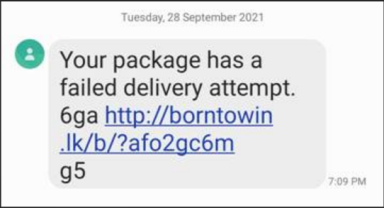
Spark bill payment error scam
This scam is sent from a mobile number (usually beginning with 022) claiming to be Spark. It falsely advises that the payment for your latest bill couldn’t be processed by your bank. It then invites you to click a link and update your details.
This is not a legitimate text message from Spark. If you receive a message like this, do not open the link.
Posted 17 June 2020
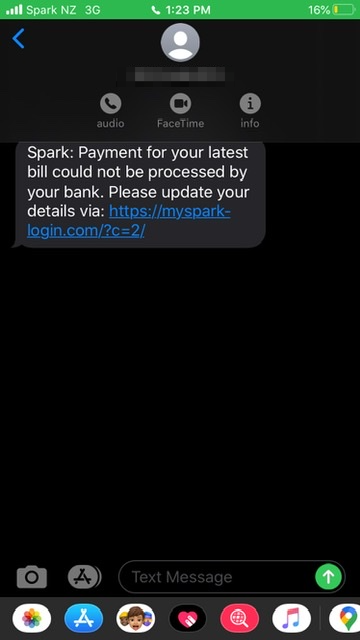
Coronavirus (COVID-19) text scams
Scammers may try to use the coronavirus (COVID-19) pandemic to scam you or steal sensitive information.
Coronavirus-related text scams may include a text message with a link that claims to direct you to coronavirus testing facilities.
If you see a suspicious text message, do not click on any links or reply to the message. Instead, you can report it to scamhelp@spark.co.nz and we will work to block it.
Posted 2 April 2020
Courier/tracking number
This scam is a text message from a four-digit number or a standard NZ or AUS mobile number.
The message says the company has tried to deliver a parcel to a customer’s address. The message provides a fake tracking number and includes a URL to a page asking for the tracking number. This then leads to another website claiming that the status of the package is pending and that the delivery fee has not been paid.
The aim of the scammer is to convince the customer to enter their personal and financial information to exploit you for financial gain. Do not open the link.
Posted 12 September 2019, updated 11 December 2020
Spark account information scam
- Scammers may contact you unexpectedly, claiming to be from Spark. Their tactics can vary — they might offer unbelievable deals or say they’ve detected suspicious activity on your account. Their goal is to trick you into sharing personal information, such as your account number or plan details.
- Please remember to never share your personal account details with someone who calls you out of the blue. Never share account information. Instead, hang up and contact Spark using our publicly listed contact information.
Coronavirus (COVID-19) phone scams
Scammers may try to use the coronavirus (COVID-19) pandemic to scam you. Some coronavirus-related phone scams are circulating, including:
- cold calls with fake investment opportunities in things like pharmaceuticals
- pre-recorded voicemails where scammers pretend to be health professionals and claim they have your positive coronavirus test results, saying you need to share your credit card details with them so they can send you medication
Spark technician scam
This scam is when you get a call and the caller says they're from a trusted organisation like Spark, another telecommunications company or Microsoft. The caller will usually say something like one or more of the following:
- There's a problem with your phone, internet or computer
- They’ve received a report that you’re experiencing slow internet
- They understand you’ve had Fibre installed and they’d like to run some tests
- That they need you to update your information with them
- That Spark has had an internal breach which means your modem, email or device has been hacked
The caller may also use scare tactics to create a sense of urgency. For example, "you must pay your account now or you'll lose connection immediately".
Once the scammer has your attention, they'll often ask you to log on to your computer and download an application (for example, "TeamViewer" or "AweSun"). This app lets them access your computer. The scammer will then show you what they claim are problems and they'll say they can resolve the problems for a fee.
Sometimes they might ask you to do a bank transfer or credit card payment to pay for these services. If neither option is available, they'll ask you to go to Western Union to make a payment. Or, they might ask you to pay in iTunes vouchers.
There's been instances of scammers transferring victims to the "Police Cyber Crime Unit" after saying they're the subject of identity theft through their emails. Victims are then told that the police need their help to set up a "trap to catch the criminals". They're convinced to withdraw large sums of money to post to an address, or to deposit it to an account.
Automated messages
Sometimes, instead of a real person on the line, scammers will use a pre-recorded message pretending to be from Spark or other large organisations such as banks.
If the call claims to come from Spark, the message will often threaten to disconnect your broadband. It may then tell you to press a number on your keypad to speak to an operator. This would then redirect you to a scammer.
If the call claims to come from a bank, they may also ask you to press a number on your keypad or to call back what may look like a local number. If the receiver does so, they'll be put through to the bank’s supposed "anti-fraud" department. They may use various tactics to extort money, including asking you to help catch international criminals or claiming there's been fraudulent activity on your account.
These are not legitimate calls. If you receive a call like this, hang up immediately.
Government grants
This scam is when you receive a call and the caller says they're from the government grants department.
They say that because you're such a good citizen, you're going to receive a sum of money. They say that to receive the money, you must pay a sum of money first. Then, you're asked to do a bank transfer or credit card payment. After transferring the money, you don't receive any payment.
FedEx
This scam is when you receive a call where the caller says they're from FedEx. The caller says they have a parcel to deliver to a named person. If the parcel's for another member of the household, the caller will ask for their mobile number.
Shortly after, the person who answered the call about the parcel will receive a second call. This second call will have a falsified caller ID. This means it shows up as the number of the household member whose number was provided in the first call. The scammer will this time say they're from the New Zealand Police or the Federal Police and that the household member is in police custody due to them being an illegal immigrant.
The caller threatens legal action and demands money to release the household member, requesting payment by one of the following methods:
- Credit card/bank card information
- Bank transfers
- Western Union transfers
- Payments made by iTunes vouchers
Investment opportunity
This scam is when you receive a call from an international number, usually to your mobile phone. They will say they know you've expressed interest in investment opportunities or online trading. This scam can include silent calls from +44 and other international country codes. Silent calls are when there's no response after answering the call. Don't try to call the number back as you may be charged.
Wangiri ("one ring")
Sometimes scammers will make bulk calls from overseas using a premium service and hang up after only one or two rings. They do this hoping you'll call back. If you do, you'll be charged premium rates and the scammer will collect the money. These calls are usually made to mobile phones from an 0900 number.
Robo-dialling
Often scammers use what’s called robo-dialling to carry out phone scamming activity. Robo-dialling is a system that calls a list of numbers collected from various places like the phone book or dark web. If someone answers, the scammer is prompted to start talking.
If no one answers, the system may leave a silent message and you'll be charged international rates if you call the number back. It's best to avoid returning calls from international numbers you don't recognise. Wait for them to leave a voicemail message or contact you another way. If you have family, friends or colleagues who are overseas, save their number.
Spark offers a product that can prevent these types of calls from coming through to you. It's called Call Screen. The Call Screen home phone can help by prompting callers with unsaved numbers to leave their name. Until they do, your phone will not ring. Robo-dialling systems can't leave a name, so the phone won't ring.
You can find more information about Call Screen at spark.co.nz/callscreen
Chinese community scam
This scam is when someone receives an call from what looks like a local number. When the person picks up the phone they hear a pre-recorded message in Chinese. It says they're calling from the Chinese embassy and asks people to press two to hear a message from them.
This scam targets the Chinese community. The call connects to the fake embassy and is then transferred to someone pretending to be from the Chinese police. The goal of the caller is to get passport and bank account details.
请广大客户小心提防最近的一些中文诈骗电话. 此类电话经常伪装成新西兰本地座机号码. 当接听时会有一段提前录制的中文语音留言并自称是“中国大使馆”或“领事馆”等官方机构打来. 留言会让接听者按“2”听余下留言.
此类诈骗电话专门针对新西兰本地华人社团, 并欺骗或有时威胁接听者“中国警方”会和他们联系. 诈骗者会借次机会骗取接听者的护照或银行账号和密码信息.
如果你接到此类诈骗电话, 可以选择立即挂断或者把号码加入黑名单. 如果你是客户请给我们发邮件(scamhelp@spark.co.nz)或向政府网络安全部门Netsafe报告此类诈骗电话
如果你不慎向诈骗者透漏你的个人信息或密码, 请马上重置你的密码.
如果你不慎向诈骗者透漏你的银行信息, 请立即通知你的银行.
No access to Spark account email scam
We’re aware of a scam email that claims to be from Spark.co.nz. It says that you have no more access to your Spark account and to follow a link to recover your account.
These are not legitimate communications from Spark and we strongly encourage you not to click on any links in the email if you receive one.
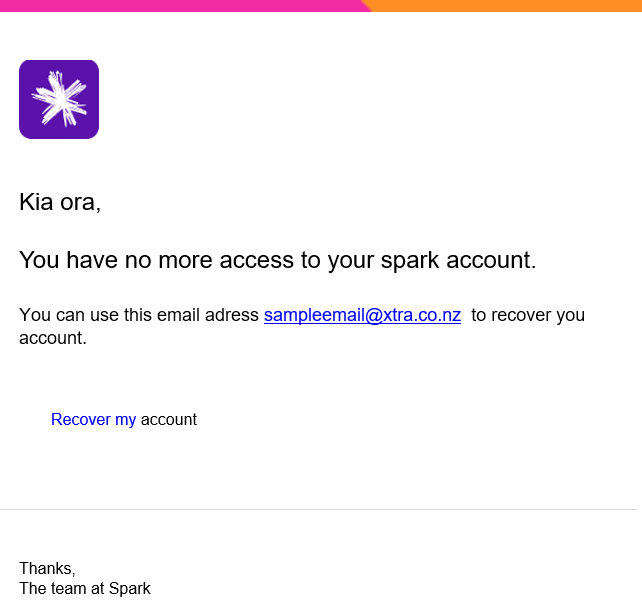
Posted 1 May 2023
Unread voicemail email scam
We’re aware of a scam email that claims to be from Spark.co.nz. It says that you have an unread voicemail. A screenshot of the email is below.
These are not legitimate communications from Spark and we strongly encourage you not to click on any links in the email if you receive one.
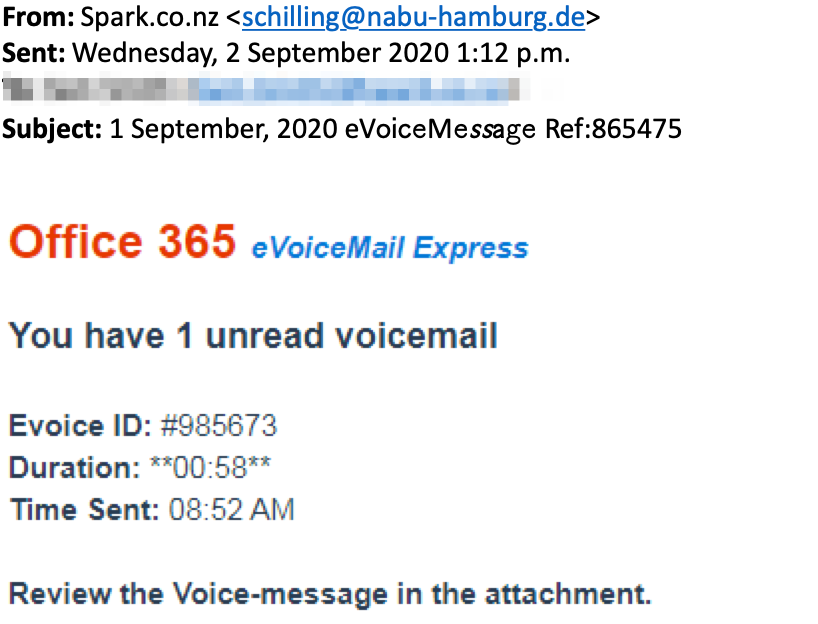
Posted 2 September 2020
Fake Spark bill
We’re aware of a scam email that asks people pay their Spark bill. A screenshot of the fake email is below.
These are not legitimate communications from Spark and we strongly encourage you not to click on any links in the email if you receive one.
If you're not sure whether your Spark bill is genuine, here are some key things to look for:
- The due date on the Spark Bill will always be approximately 14 days from the receipt of the bill. In this instance, the due date is one day away which indicates that the bill is not genuine.
- The account number will always be your account number. If the number in the email is different from your account number, this would indicate that the bill is not genuine.
- The amount owing will always match the amount shown on your Spark app and in MySpark. If the amount in the email is different, this indicates that the bill is not genuine.
Always check your Spark app or MySpark to verify your due date, account number, and actual amount owing.
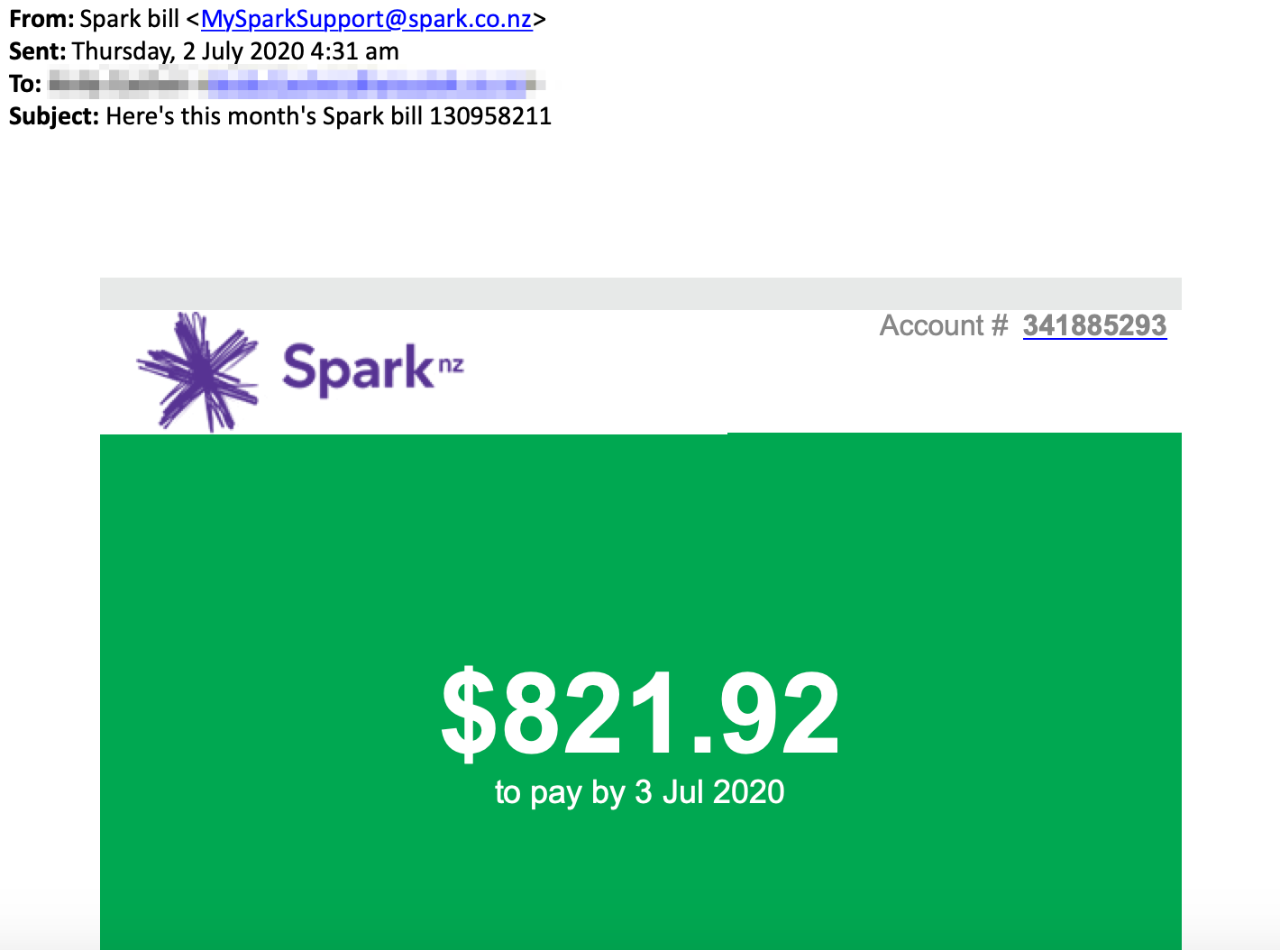
Updated 2 July 2020
Coronavirus (COVID-19) related scams
Scammers may try to use the coronavirus (COVID-19) pandemic to scam you or steal sensitive information. If you see a suspicious email, do not click on any links or open any attachments. If you receive an email like the ones below, report it to your email provider then delete the email.
Some coronavirus-related email scams include the following:
- An email claiming to be from the Ministry of Education (MOE) or health agency with advice related to the virus. These emails may have links and/or attachments which suggest that you can see further information. These links and attachments actually install malicious software (malware) that's designed to steal personal information from your device.
- An email in which the scammer threatens to infect you and your family with coronavirus if you don’t pay a ransom.
- An email in which you're invited to download a "coronavirus map" application. It actually installs malicious software (malware) that's designed to steal personal information from your device.
- An email claiming to be from the World Health Organisation (WHO) with "COVID-19" in the subject line. The scammer requests the recipient to donate to the WHO COVID-19 Response Fund using their digital wallet. This is not legitimate communication from WHO.
- An email claiming to be from Spark with the subject line "We wish you an entertaining quarantine". It's offering a 12-month free streaming service to keep people entertained while in quarantine. This is not legitimate communication from Spark. See example screenshot below:
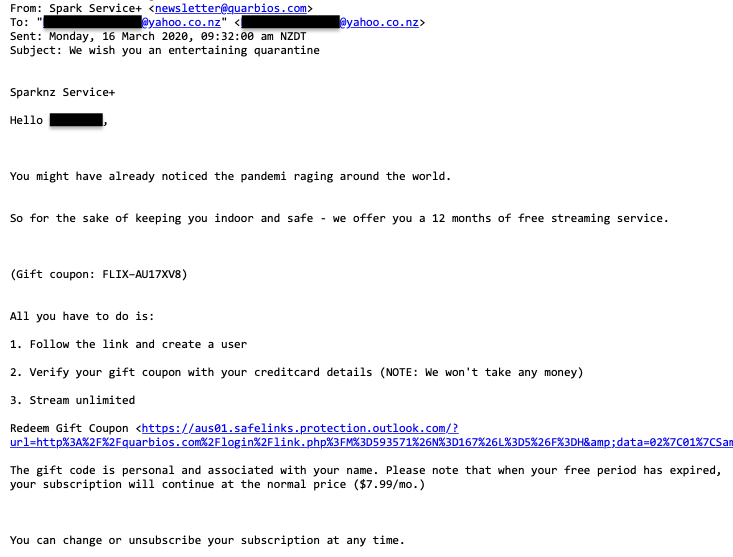
Updated 30 March 2020
Xtra email account suspension
This scam appears to come from Xtramail/Spark. It claims that the storage in your email account has been limited and so your account has been temporarily suspended. The email asks you to open a link called "Click here to regain access". It opens a page that asks you to log in and verify your personal details.
This is not legitimate communication from Spark or Xtramail. If you receive an email like this, do not click on the link.
- From: Xtramail <morphoi@xtra.co.nz>
- Subject line: Confirm your email storage
- Content: Spark NZ logo with alt text "Comcast" and the text, "Just to let you know that we noticed that the storage of your email account is being limited during our regular update today."
- See screenshot below:
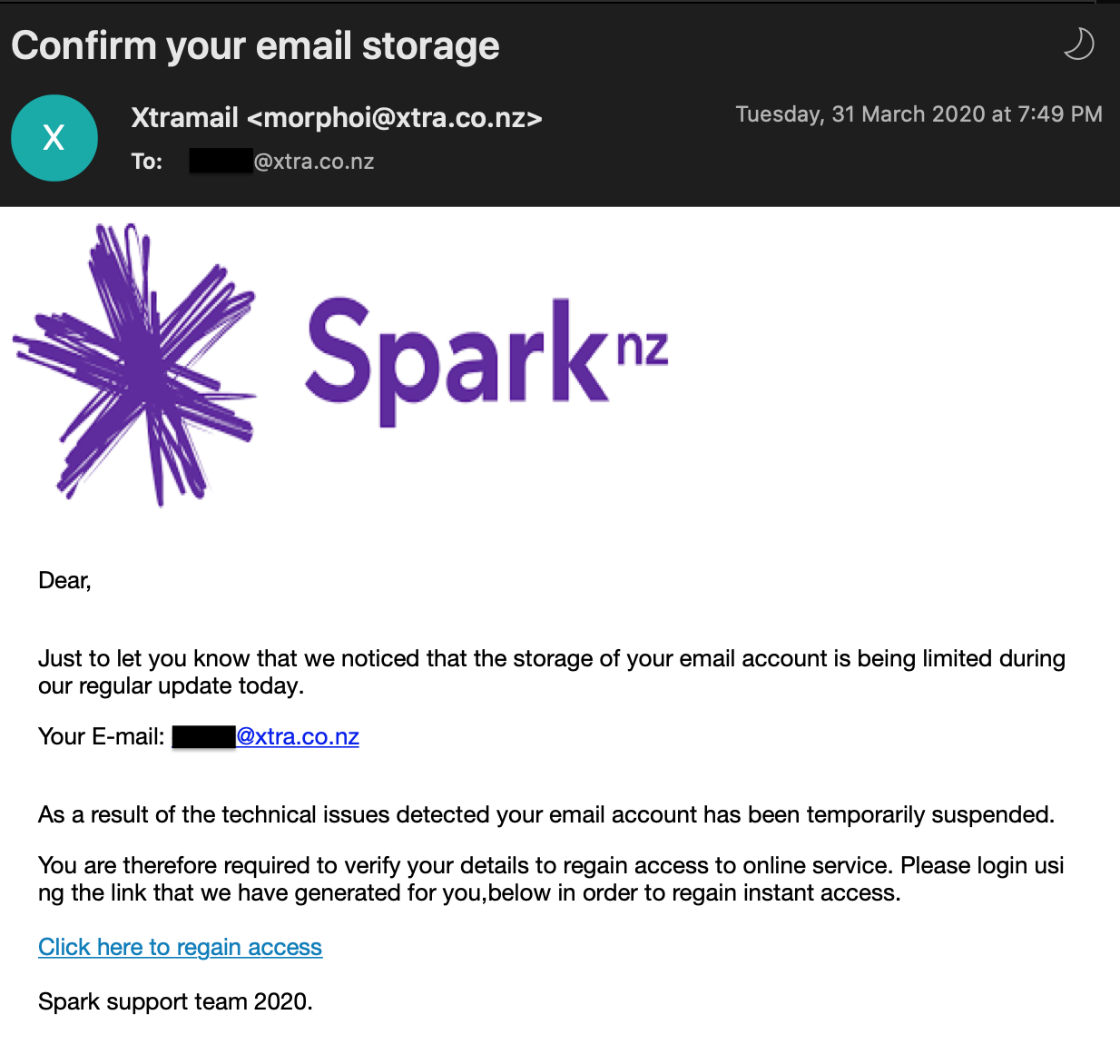
Spark privacy email
This scam email asks you to confirm your Spark ID by clicking on a link called "Verify my Spark ID username".
This is not legitimate communication from Spark. It's a scam aimed at getting your personal information.
Do not click on the link in the email.
- From: Spark
- Subject line: Confirm your Spark ID
- Content: Purple banner with the text "Your privacy made clearer" and the text "Due to Spark New Zealand security and anti-fraud regulations, users must provide proof of identification in order to continue to use our services, just click on the link below."
Posted 19 February 2020
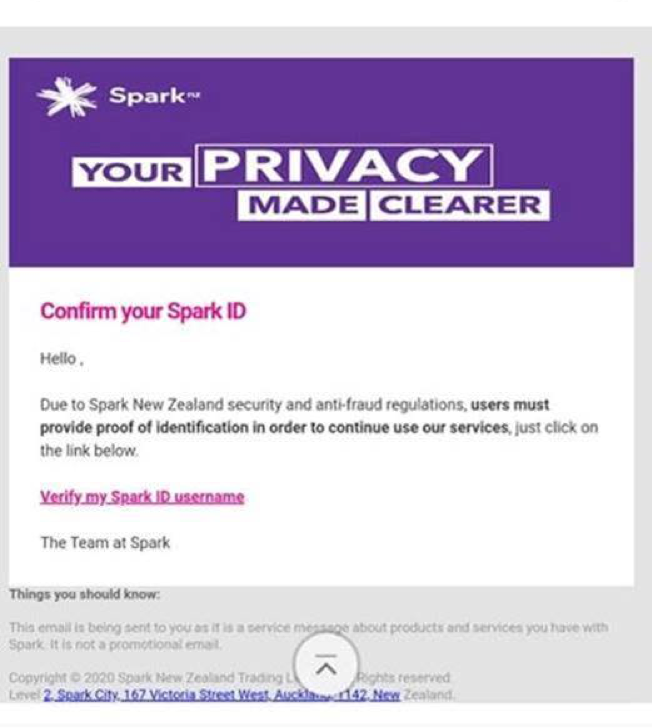
Spark gift
This scam is an email or pop-up that looks like it's from Spark. It might tell people that they've been chosen to be a part of a yearly draw and get a free prize as thanks for being a loyal Spark customer or that they’re among 100 users selected as part of Spark’s loyalty program. They may claim to have smartphones, Countdown gift cards and iPhones up for grabs. All you have to do is answer some anonymous questions for a customer survey.
The aim of this scam is to get personal information about you. Scammers then use this information to make targeted scam calls.
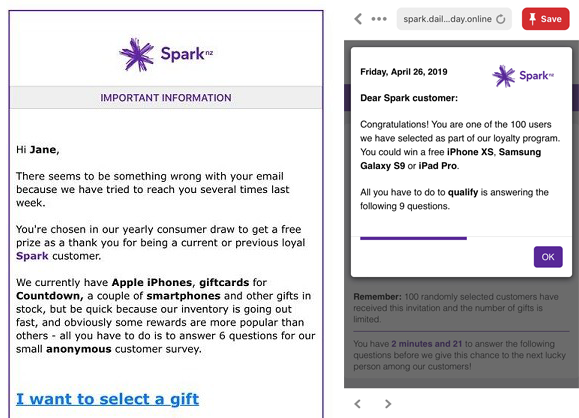
Fake Spark invoice to Xtra Mail email
Xtra Mail customers receive an email that looks like a Spark NZ bill. It prompts you to view your bill and pay through a link. The link will direct you to a website that asks you to enter your personal information.
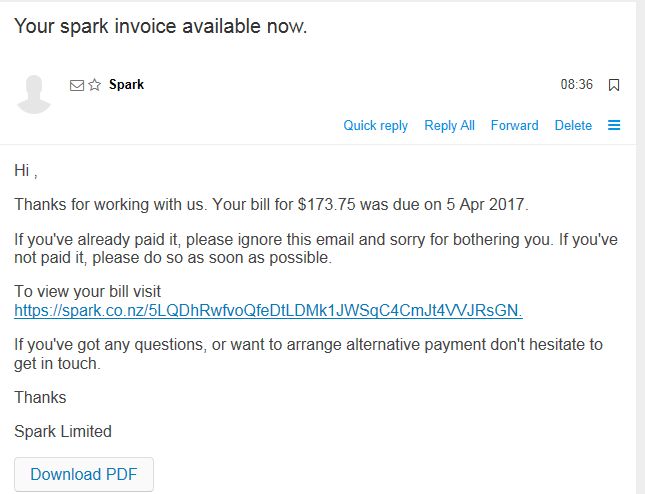
Fraudulent invoice scam
This scam can occur on any email platform, not only Xtra Mail. It usually only occurs if a scammer has gained access to your email because they have your login details.
Once the scammer has gained access to your email, they set up an auto-forwarding rule which sends a copy of all the emails you receive to a different email account.
The scammer then monitors your emails to understand more about you and what you're up to. They use this information to send you fraudulent emails and requests for money. For example, they might send a fake invoice that looks like a bill you're expecting, but it will have different bank payment details.
If you pay this invoice, the scammers will move your money offshore very fast. The Police and your bank may find it difficult to reclaim that money.
If Spark becomes aware your Xtra Mail account has had unauthorised access we'll:
- Reset your Xtra Mail password
- Remove any auto-forwarding rules and notify you
It’s often hard to track this kind of activity. It’s important to be very wary of any previous or future requests for large sums of money.
- If you receive any large invoices it's a good idea to call the business to double check it's genuine and the account details are correct before you pay
- Call the business on the phone number you have recorded for them or look it up on their website or in the phone book. Don't call the phone number on the email as it likely belongs to the scammer.
If you think someone has accessed your email account:
- Follow the instructions on this page to report the scam. Report a scam
- Find tips on how to keep your account secure going forward. Keep my email secure
- Find out more information on this scam on the Netsafe website. Visit Netsafe website
Spark account update
This scam involves receiving a fake account update via email. It asks you to upgrade your service or your account will be closed.
- From: Spark Notice
- Subject line: *Action required: Reset your Spark account*
Posted 31 October 2019
Password reset scam
This scam appears to come from Spark’s support team. It claims you’ve requested a password reset and asks you to sign in to confirm. The link included in the message appears to be genuine, but instead directs you to a fake page.
- From: Spark Support <support@spark.co.nz>
- Subject line: Password Change Confirmation
To safely reset your Xtra email password, type spark.co.nz/xtramail into your web browser and select Can’t sign in.
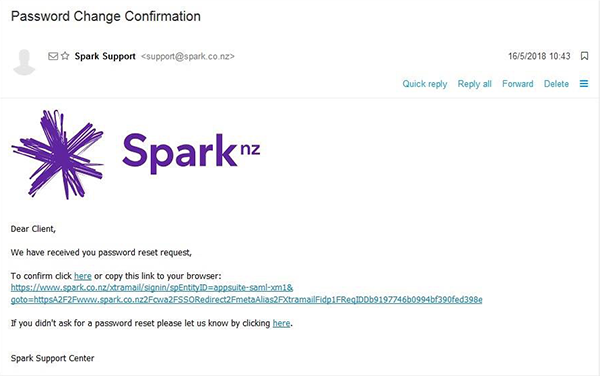
Blackmail scam
This scam attempts to blackmail recipients to pay money or risk having their personal details exposed to family and friends. The scammer claims to have installed malware on the recipient’s device and has accessed their password as well as potentially embarrassing footage.
In an attempt to make the email more believable, the scammer will include an old password. The scammer obtains these passwords through historic breaches from other organisations.
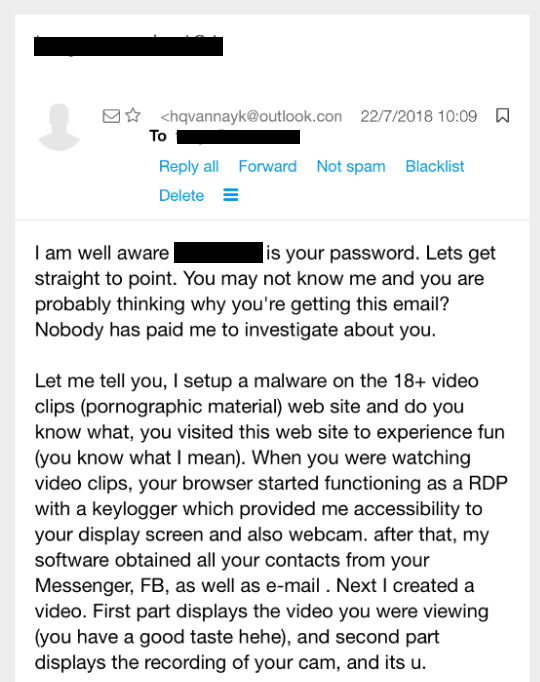
Xtra Mail scam
We’re aware of a scam email that asks people to recover their Xtra Mail account and update their billing information due to the account being inactive. The email asks you to open a link called ‘Recover Now’. A screenshot of the fake email is below.
These are not legitimate communications from Spark or Xtra Mail and we strongly encourage you not to click on any links in the email if you receive one.
- From: SPARK REMINDER dupbos@xtra.co.nz
- Subject: Recover your account!
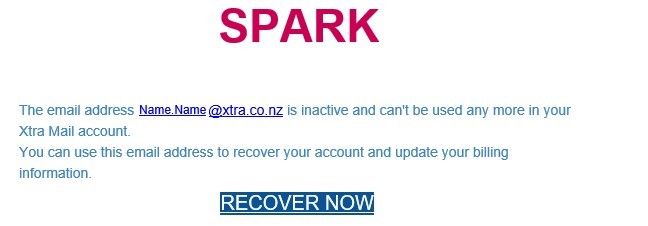
Xtra Mail storage scam
We’re aware of a scam email that asks people to log into their Xtra Mail account to upgrade their storage which has been exceeded. The email asks you to open a link called ‘Verify Now’. A screenshot of the fake email is below.
These are not legitimate communications from Spark or Xtra Mail and we strongly encourage you not to click on any links in the email if you receive one.
- From: Xtramail spark-customer@xtra.co.nz
- Subject: Alert Xtramail: Renew your storage
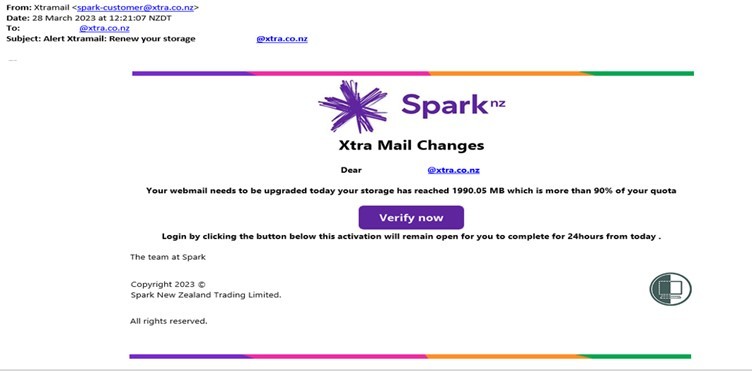
Gift pop up
This website pop up looks like it’s from Spark. It claims you're in the draw to win a fantastic prize such as a new phone or laptop – see example below.
This is not a legitimate Spark offer and you should exit out of it rather than clicking ‘OK’.
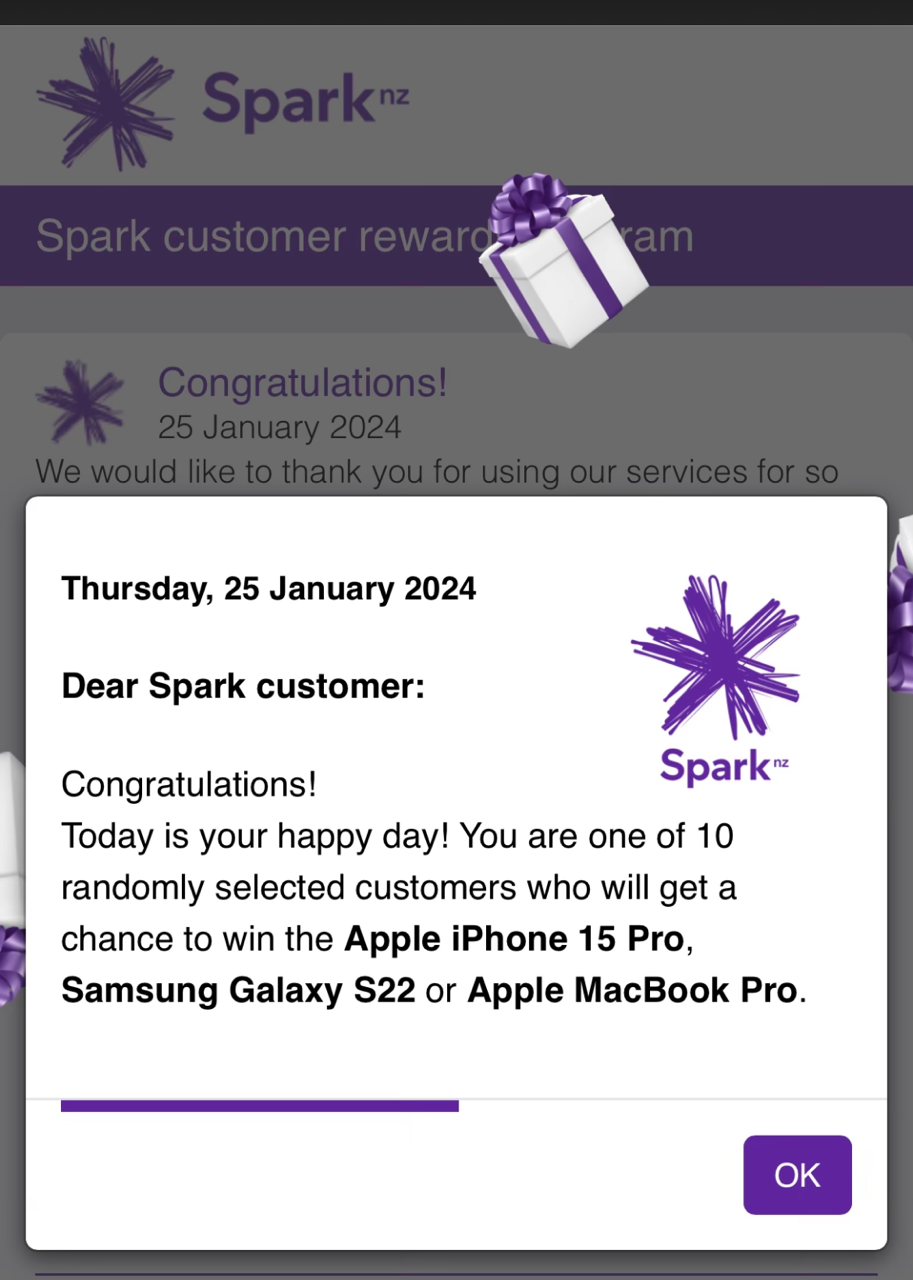
Signal booster scam
We’re aware of some third-party websites selling signal boosters. These websites misuse Spark’s brand in an attempt to prove credibility. But these signal boosters are not endorsed by Spark. A screenshot example of this is below.
These devices aren't approved in New Zealand because they interfere with how mobile networks operate. They can also cause calls to drop. The use of unlicensed equipment may result in infringement offence penalties and possible prosecution.
You can find more information about this on the NZ Government’s Radio Spectrum Management website
If you're having issues with network coverage, please get in touch with Spark to discuss your options.
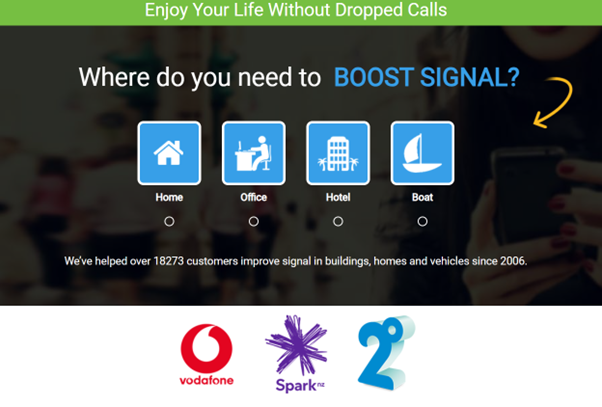
Account payment discount scheme (Discount Club)
We’re aware of an organisation calling itself the ‘Discount Club’ contacting Spark customers via social media platforms such as WhatsApp and WeChat and offering to top up their Spark accounts at a discounted rate. While this may seem like a way to save you money, the Discount Club uses stolen credit cards to make any promised Spark account top-ups, which will not be accepted by Spark. If you’re contacted about this, please do not participate in this scheme.
Posted 28 November 2022
Reduced Spark bill ad on Skykiwi.com
We understand that a display ad is appearing on some websites, including Skykiwi.com. The ad looks as though it's from Spark and claims that you can get a discount on your Spark bill.
After clicking on the ad, the scammer gets in touch via WeChat and the victim transfers the discounted amount to the scammer. The scammers then pockets that money and pays the victim’s bill using stolen credit card details with the intention of quickly reversing the payment. In most instances, the transactions fail or the scammer immediately reverses the payments and the victim is left with the same amount owing on their Spark account after having also given money to the scammer.
This ad is not a legitimate Spark advertisement. We strongly encourage you not to click on this ad or participate in the scheme.
Posted 28 July 2020
Spark Sessions & other livestreaming scams
Some scammers are posting comments that contain phishing links on companies' Facebook posts.
For example, a scammer posted a comment on a Spark post with a link to stream Spark Sessions. The link took the user to another website that asked for credit card details. This comment has been removed.
Our Spark Sessions livestreams and videos are only available on the official Spark Facebook page and are free for everyone to enjoy. Spark will never ask for your credit card details on any of our social media channels.
Avoid clicking on any links in comments under posts from sources you don’t know.
Posted 14 May 2020
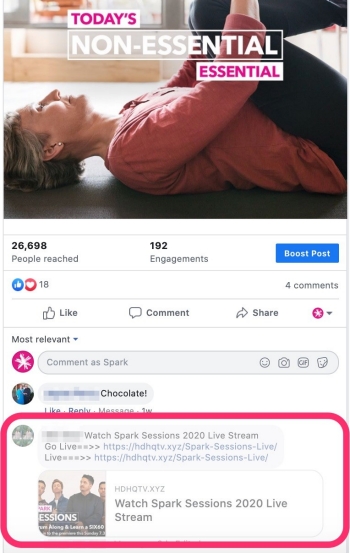
Facebook profiles impersonating NZ companies
Scammers are setting up fake Facebook profiles under the names of New Zealand companies to pretend to sell electronic goods.
For example, a scammer with the account name "Spark store manukau" made a post advertising an Apple iPhone 11 Pro Max with a free Apple Watch (see screenshot below). This page was immediately reported and removed.
Victims of these types of scams have transferred money into a New Zealand bank account number but never receive the order.
Spark will never ask for your credit card details on any of our social media channels or ask you to make payments via Facebook Messenger.
Before purchasing items on Facebook, especially if the deal seems yoo good to be true, contact the relevant company to check whether the promotion is legitimate.
Posted 14 May 2020
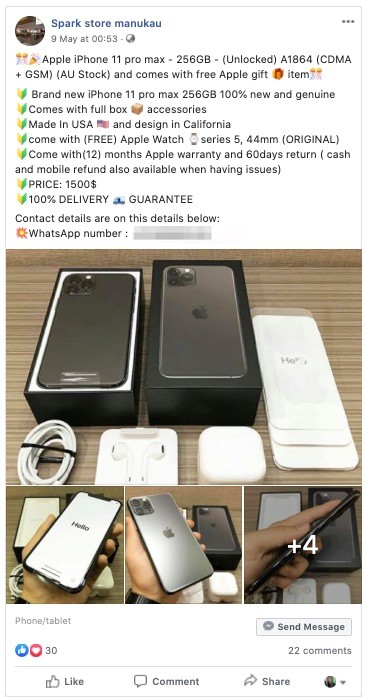
NZ citizen application scam websites
Te Tari Taiwhenua | Department of Internal Affairs (DIA) has warned that some people have been tricked into using an unofficial website to apply for New Zealand citizenship.
Citizenship applications require personal information, so it’s important to ensure you’re only applying for citizenship using the legitimate site.
The only website for applying for a citizenship grant is govt.nz
Posted 28 May 2020
What now?
- Can't find a scam above? It might be new, so let us know. Report a scam
